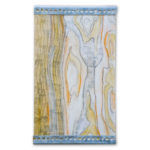
Reclaimed In Nature
We recycle bottles and cans. We compost our table scraps and we plant trees. We eat organic and use compact florescent lighting. However, I couldn’t help but think, as I am doing my art work, that the canvas is bleached cotton that was not raised in an earth-friendly manner. The acrylic paints are a petrochemical-based product. Turpentine vapors damage the ozone. I thought about the dichotomy of how art can bring awareness to the environment, but that the art itself can be a hazard to the environment.
Green. As a buzz word. A band wagon. A way of life. I decided to use recycled materials that arrive as pollution or waste, and create art with it.
I like to tie my work into a framework of history. To remind the viewer that “it” has been here before us, and will exist after us. Time gives weight and perspective to the global changes/degradation and value to the things we are losing. If we have no collective memory, we have no sense of loss.
STYLE
The pieces are made to look old, arriving fully-formed with a history. Some recall Victorian dioramas, sample boards or childhood collections of bugs and butterflies. Others recall archeological digs, or small rural museums with crackled field paintings of wildlife and nature. In this context, they speak to man’s impact on nature. They are reflective of the past, but not truly of it.
MATERIALS
Most are “found,” objects, some collected off one of the beaches in San Francisco.
Ft. Funston suffered an oil spill on January 18, 1971 and oil impregnated sand is still visible today all along the coast. A second oil spill occurred in 2009, washing up on Chrissy Field.
Chrissy Field has shotgun shells wash up on the beach in droves. Fired off the back of cruise ships or dropped into the waters of the Delta by duck hunters. They then wash downstream onto the beaches of San Francisco. Iron fishing hooks, chunks of rusted metal, rebar in cement, part of ships and other evidence of the tasks of man, wash up on to the beaches. Driftwood, burned in campfires, pieces of piers, bits of debris, chunks of glass and plastic, pile up on the high tide mark, all along the beach. Any of these might become fodder for my artwork.
- Oil soaked sand, 1974 Ocean Beach, Fort Funston
Bird feather









